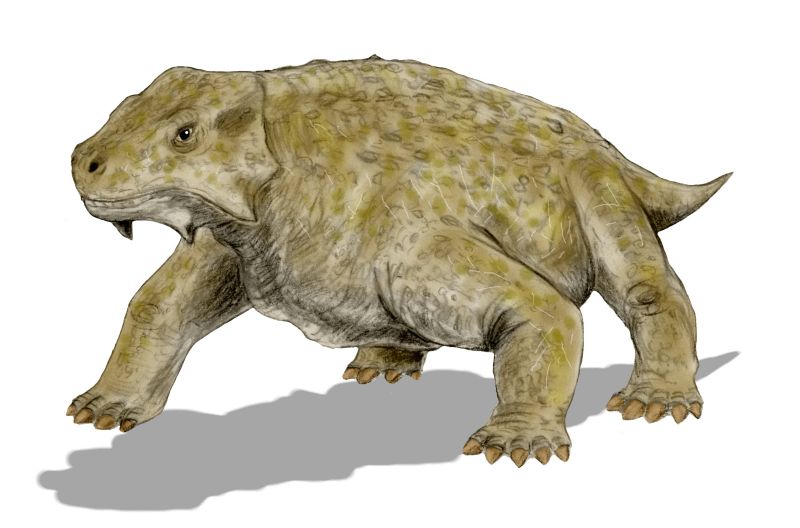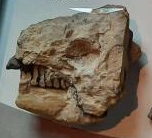|
Pumiliopareia
''Pumiliopareia'' is an extinct genus of pareiasaurid parareptile from the Permian period of South Africa. It is known from a complete skeleton with osteoderms. Description ''Pumiliopareia'' was about 50 cm (19.6 in) in length with a 12 cm (4.7 in) skull. It is the smallest known member of the pareiasaurs, measuring only a fifth as long as some of its larger relatives. Like '' Anthodon'', its body was entirely covered with osteoderms. In analyses that support a pareiasaur origin of turtles, the sister taxon of the testudines. However it specifically shares with turtles a single trait only: Ribs greatly expanded anteroposteriorly (i.e. wide). Classification Originally included under the genus '' Nanoparia'', it was given its own name by Lee 1997 who found it did not form a clade with ''Nanoparia luckhoffi'', the type species of that genus, and preferred to have monophyletic genera. ''Nanoparia'' may still be a paraphyletic Paraphyly is a taxonomic term describing ... [...More Info...] [...Related Items...] OR: [Wikipedia] [Google] [Baidu] |
Pareiasauria
Pareiasaurs (meaning "cheek lizards") are an extinct clade of large, herbivorous parareptiles. Members of the group were armoured with osteoderms which covered large areas of the body. They first appeared in southern Pangea during the Middle Permian, before becoming globally distributed during the Late Permian. Pareiasaurs were the largest reptiles of the Permian, some reaching sizes over , equivalent to the largest contemporary therapsids. Pareiasaurs became extinct in the end-Permian mass extinction event. Description Pareiasaurs ranged in size from long, with some species estimated to exceed in body mass. The limbs of many parieasaurs were extremely robust, likely to account for the increased stress on their limbs caused by their typically sprawling posture. The cow-sized '' Bunostegos'' differed from other pareiasaurs by having a more upright limb posture, being amongst the first amniotes to develop this trait. Pareiasaurs were protected by bony scutes called osteoderms ... [...More Info...] [...Related Items...] OR: [Wikipedia] [Google] [Baidu] |
Pumiliopareiasauria
Pareiasaurs (meaning "cheek lizards") are an extinct clade of large, herbivorous parareptiles. Members of the group were armoured with osteoderms which covered large areas of the body. They first appeared in southern Pangea during the Middle Permian, before becoming globally distributed during the Late Permian. Pareiasaurs were the largest reptiles of the Permian, some reaching sizes over , equivalent to the largest contemporary therapsids. Pareiasaurs became extinct in the end-Permian mass extinction event. Description Pareiasaurs ranged in size from long, with some species estimated to exceed in body mass. The limbs of many parieasaurs were extremely robust, likely to account for the increased stress on their limbs caused by their typically sprawling posture. The cow-sized ''Bunostegos'' differed from other pareiasaurs by having a more upright limb posture, being amongst the first amniotes to develop this trait. Pareiasaurs were protected by bony scutes called osteoderms th ... [...More Info...] [...Related Items...] OR: [Wikipedia] [Google] [Baidu] |
Pareiasauridae
Pareiasaurs (meaning "cheek lizards") are an extinct clade of large, herbivorous parareptiles. Members of the group were armoured with osteoderms which covered large areas of the body. They first appeared in southern Pangea during the Middle Permian, before becoming globally distributed during the Late Permian. Pareiasaurs were the largest reptiles of the Permian, some reaching sizes over , equivalent to the largest contemporary therapsids. Pareiasaurs became extinct in the end-Permian mass extinction event. Description Pareiasaurs ranged in size from long, with some species estimated to exceed in body mass. The limbs of many parieasaurs were extremely robust, likely to account for the increased stress on their limbs caused by their typically sprawling posture. The cow-sized '' Bunostegos'' differed from other pareiasaurs by having a more upright limb posture, being amongst the first amniotes to develop this trait. Pareiasaurs were protected by bony scutes called osteoderms ... [...More Info...] [...Related Items...] OR: [Wikipedia] [Google] [Baidu] |
Pumiliopareiasauria
Pareiasaurs (meaning "cheek lizards") are an extinct clade of large, herbivorous parareptiles. Members of the group were armoured with osteoderms which covered large areas of the body. They first appeared in southern Pangea during the Middle Permian, before becoming globally distributed during the Late Permian. Pareiasaurs were the largest reptiles of the Permian, some reaching sizes over , equivalent to the largest contemporary therapsids. Pareiasaurs became extinct in the end-Permian mass extinction event. Description Pareiasaurs ranged in size from long, with some species estimated to exceed in body mass. The limbs of many parieasaurs were extremely robust, likely to account for the increased stress on their limbs caused by their typically sprawling posture. The cow-sized ''Bunostegos'' differed from other pareiasaurs by having a more upright limb posture, being amongst the first amniotes to develop this trait. Pareiasaurs were protected by bony scutes called osteoderms th ... [...More Info...] [...Related Items...] OR: [Wikipedia] [Google] [Baidu] |
Anthodon (reptile)
''Anthodon'' (meaning "flower tooth") is an extinct genus of pareiasaur parareptile from the Permian period of South Africa and Tanzania. History In 1845, amateur geologists William Guybon Atherstone and Andrew Geddes Bain discovered several fossils near Dassieklip, Cape Province, in the Bushman's River Valley. This was the first dinosaur find in Africa and in the Southern Hemisphere. In 1849 and 1853, Bain sent some of the fossils to palaeontologist Richard Owen for identification. Among them was an upper jaw Bain referred to as the "Cape ''Iguanodon''", so the site was named "Iguanodonhoek". Atherstone published a short paper about the discovery in 1857,Atherstone, W.G. (1857). "Geology of Uitenhage". ''The Eastern Province Monthly Magazine''. 1 (10): 518–532. but lamented in 1871 that it had thus far received no attention in London. In 1876 Owen named a series of specimens from the collection ''Anthodon serrarius'', basing the generic name on the resemblance of the teeth ... [...More Info...] [...Related Items...] OR: [Wikipedia] [Google] [Baidu] |
Nanoparia
''Nanoparia'' is an extinct genus of pareiasaur that lived in the Permian. Description It was about 60 cm (23.6 in) in length, and weighed around 8 to 10 kilograms (17.6-22 lbs). Classification This is an unusual small, spiny specialised form. The skull is very similar to that of Pareiasaurus and Romer considered it a synonym of the latter. Orlov however (in Osnovy Paleontology, the monumental multi-volume Russian textbook of Paleontology) placed it in the Elginiinae. Kuhn (1969) however argues that while resembling Elginia in the ossifications at the rear of the skull, it differs completely in proportions and would not seem to be related. Lee (1997) considers it a basal member of the dwarf pareiasaurs. ''Nanoparia'' is believed to be among the pareiasaur genera most closely related to turtles Turtles are reptiles of the order Testudines, characterized by a special shell developed mainly from their ribs. Modern turtles are divided into two major groups, the Pl ... [...More Info...] [...Related Items...] OR: [Wikipedia] [Google] [Baidu] |
Changhsingian
In the geologic time scale, the Changhsingian or Changxingian is the latest age or uppermost stage of the Permian. It is also the upper or latest of two subdivisions of the Lopingian Epoch or Series. The Changhsingian lasted from to 251.9 Ma ago. It is preceded by the Wuchiapingian age/stage and is followed by the Induan age/stage (Early Triassic epoch). The greatest mass extinction in the Phanerozoic eon, the Permian–Triassic extinction event, occurred around the end of this age. Stratigraphic definitions The Changhsingian is named after Changxing () in northern Zhejiang, China. The stage was named for the Changhsing Limestone. The name was first used for a stage in 1970 and was anchored in the international timescale in 1981.. The base of the Changhsingian Stage is at the first appearance of the conodont species '' Clarkina wangi''. The global reference profile is profile D at Meishan, in the type area in Changxing, just below the Changhsingian foraminifer index fossi ... [...More Info...] [...Related Items...] OR: [Wikipedia] [Google] [Baidu] |
Changhsingian Life
In the geologic time scale, the Changhsingian or Changxingian is the latest age or uppermost stage of the Permian. It is also the upper or latest of two subdivisions of the Lopingian Epoch or Series. The Changhsingian lasted from to 251.9 Ma ago. It is preceded by the Wuchiapingian age/stage and is followed by the Induan age/stage (Early Triassic epoch). The greatest mass extinction in the Phanerozoic eon, the Permian–Triassic extinction event, occurred around the end of this age. Stratigraphic definitions The Changhsingian is named after Changxing () in northern Zhejiang, China. The stage was named for the Changhsing Limestone. The name was first used for a stage in 1970 and was anchored in the international timescale in 1981.. The base of the Changhsingian Stage is at the first appearance of the conodont species '' Clarkina wangi''. The global reference profile is profile D at Meishan, in the type area in Changxing, just below the Changhsingian foraminifer index fossil ... [...More Info...] [...Related Items...] OR: [Wikipedia] [Google] [Baidu] |
Lopingian Reptiles Of Africa
The Lopingian is the uppermost series/last epoch of the Permian. It is the last epoch of the Paleozoic. The Lopingian was preceded by the Guadalupian and followed by the Early Triassic. The Lopingian is often synonymous with the informal terms late Permian or upper Permian. The name was introduced by Amadeus William Grabau in 1931 and derives from Leping, Jiangxi in China. It consists of two stages/ ages. The earlier is the Wuchiapingian and the later is the Changhsingian. The International Chronostratigraphic Chart (v2018/07) provides a numerical age of 259.1 ±0.5 Ma. If a Global Boundary Stratotype Section and Point (GSSP) has been approved, the lower boundary of the earliest stage determines numerical age of an epoch. The GSSP for the Wuchiapingian has a numerical age of 259.8 ± 0.4 Ma. Evidence from Milankovitch cycles suggests that the length of an Earth day during this epoch was approximately 22 hours. Geography During the Lopingian, most of the earth was in t ... [...More Info...] [...Related Items...] OR: [Wikipedia] [Google] [Baidu] |
Paraphyletic
Paraphyly is a taxonomic term describing a grouping that consists of the grouping's last common ancestor and some but not all of its descendant lineages. The grouping is said to be paraphyletic ''with respect to'' the excluded subgroups. In contrast, a monophyletic grouping (a clade) includes a common ancestor and ''all'' of its descendants. The terms are commonly used in phylogenetics (a subfield of biology) and in the tree model of historical linguistics. Paraphyletic groups are identified by a combination of synapomorphies and symplesiomorphies. If many subgroups are missing from the named group, it is said to be polyparaphyletic. The term received currency during the debates of the 1960s and 1970s accompanying the rise of cladistics, having been coined by zoologist Willi Hennig to apply to well-known taxa like Reptilia (reptiles), which is paraphyletic with respect to birds. Reptilia contains the last common ancestor of reptiles and all descendants of that ancestor exc ... [...More Info...] [...Related Items...] OR: [Wikipedia] [Google] [Baidu] |
Osteoderms
Osteoderms are bony deposits forming scales, plates, or other structures based in the dermis. Osteoderms are found in many groups of Extant taxon, extant and extinct reptiles and amphibians, including lizards, crocodilians, frogs, Temnospondyli, temnospondyls (extinct amphibians), various groups of dinosaurs (most notably ankylosaurs and stegosaurians), phytosaurs, aetosaurs, placodonts, and hupehsuchians (marine reptiles with possible ichthyosaur affinities). Osteoderms are uncommon in mammals, although they have occurred in many xenarthrans (armadillos and the extinct glyptodonts and Mylodontidae, mylodontid ground sloths). The heavy, bony osteoderms have evolved independently in many different lineages. The armadillo osteoderm is believed to develop in subcutaneous dermal tissues. These varied structures should be thought of as anatomical analogues, not homology (biology), homologues, and do not necessarily indicate monophyly. The structures are however derived from scute, sc ... [...More Info...] [...Related Items...] OR: [Wikipedia] [Google] [Baidu] |



